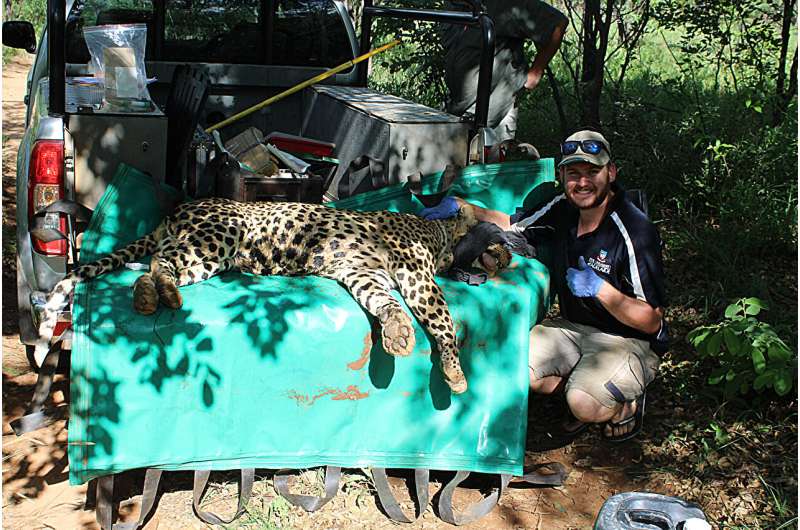This article has been reviewed according to Science X's editorial process and policies. Editors have highlighted the following attributes while ensuring the content's credibility:
fact-checked
peer-reviewed publication
trusted source
proofread
High genetic diversity discovered in South African leopards

Researchers say the discovery of very high genetic diversity in leopards found in the Highveld region of South Africa has increased the need for conservation efforts to protect leopards in the country.
The discovery was published in the journal PeerJ and builds upon another leopard study published by the research team.
Declan Morris, a Ph.D. candidate with the University of Adelaide's School of Animal and Veterinary Sciences, led the research project, which discovered that the two maternal lineages of leopards found in Africa overlap in the Highveld, leading to the high genetic diversity.
One lineage can be found across most of the African continent, while the other is confined mostly to the Western Cape, Eastern Cape, KwaZulu-Natal and Mpumalanga regions of South Africa.
"We compiled the most comprehensive mitochondrial DNA (mtDNA) data set to date to explore the trends and leopard genetics on a continental scale," says Morris.
"The results of our analysis, using a combination of mtDNA, microsatellites, and comparisons with results of other published studies, is what enabled us to determine that the leopard population in the Highveld of Mpumalanga had the highest levels of genetic diversity in the country."
Genetic diversity is important for a species' long-term survival.
"High genetic diversity increases the ability for a species to adapt to a changing environment around it; therefore, it can make species more resilient to events such as climate change or the introduction of new diseases," says Morris.
"The discovery that the leopards in the Highveld have the highest recorded levels of genetic diversity in South Africa is significant as it places a high conservation priority for the population in the region."
It is likely the two lineages of leopards diverged between 960,000–440,000 years ago due to the aridification of the Limpopo basin between 1,000,000–600,000 years ago. Both leopard lineages are now co-mingling in the Mpumalanga Province where Morris' Ph.D. work was conducted.
"We had originally hypothesized that the Highveld leopards would be isolated as they exist in a highly fragmented region, but this discovery shows us that it's not as isolated as we thought," Morris says.
"Gene flow is occurring with Lowveld areas and Kruger National Park. We found an unexpected level of connectivity, even across landscapes highly modified by humans."
Morris, whose research team included the University of Adelaide's Dr. Todd McWhorter and Associate Professor Wayne Boardman, and collaborators from University of Pretoria and University of Venda, hopes this discovery will place a higher importance on the conservation of leopard populations in South Africa.
"This information will hopefully help change attitudes towards the management of leopards and be used to inform management decisions—such as choosing translocation instead of issuing destruction permits for problem-causing animals," he says.
"One of the biggest measures that could protect leopards in the Highveld is community engagement. Building better, stronger relationships between the community, government, researchers, and conservation organizations allows for efficient, targeted management programs to be designed."
More information: Declan R. Morris et al, Unravelling the maternal evolutionary history of the African leopard (Panthera pardus pardus), PeerJ (2024). DOI: 10.7717/peerj.17018
Journal information: PeerJ
Provided by University of Adelaide




















